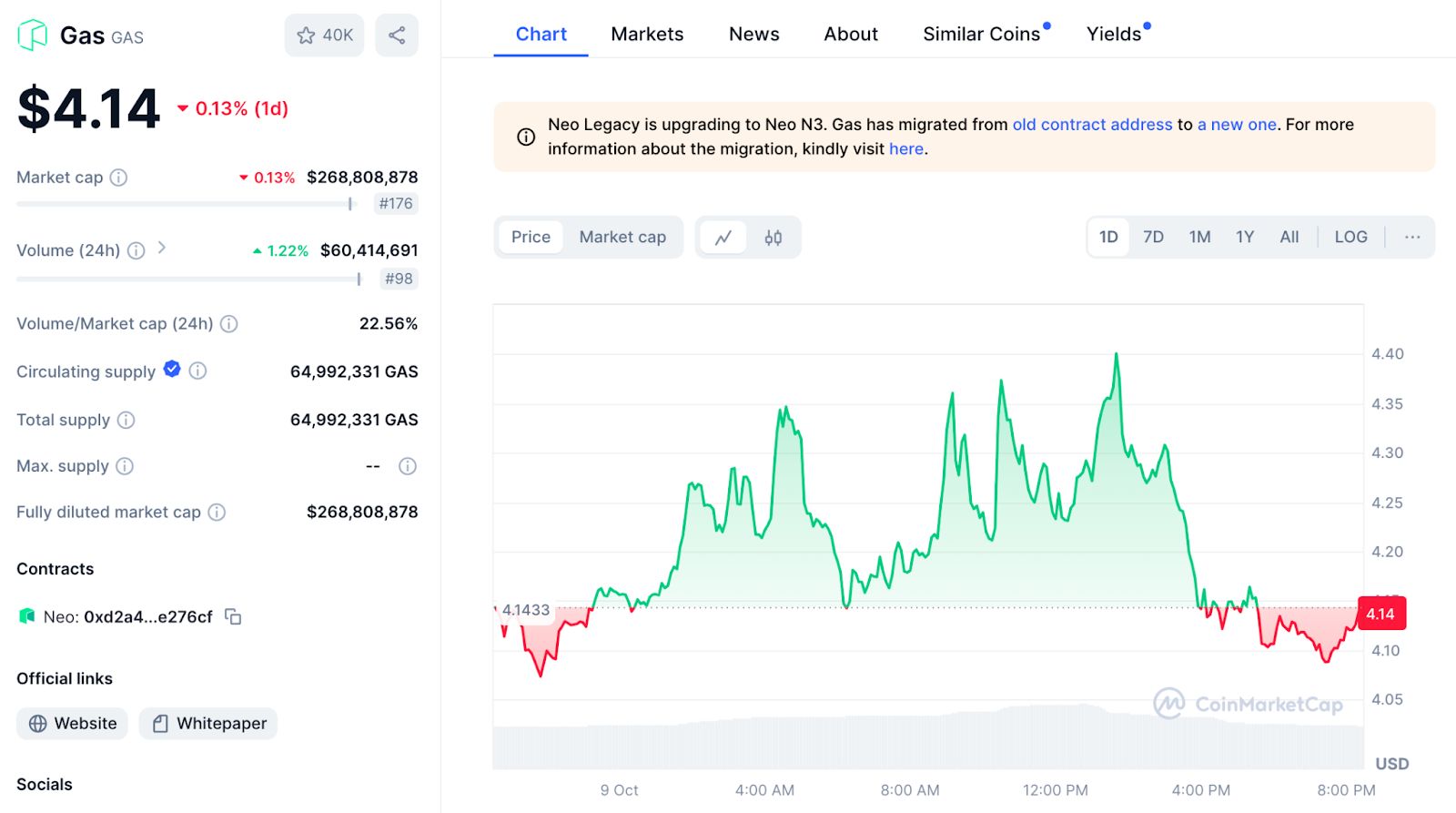Bitget:日次取引量の世界ランキングでトップ4にランクイン!
BTCマーケットシェア60.68%
Bitgetの新規上場:Pi Network
アルトコインシーズン指数:0(ビットコインシーズン)
BTC/USDT$86683.27 (-1.07%)恐怖・強欲指数40(恐怖)
ビットコイン現物ETFの純流入総額(+$89.6M(1日)、+$670.3M(7日))。プレマーケットに上場した通貨PAWS,WCT6,200 USDT相当の新規ユーザー向けウェルカムギフトパッケージ。今すぐ獲得する
Bitgetアプリでいつでもどこでも取引しましょう今すぐダウンロードする
Bitget:日次取引量の世界ランキングでトップ4にランクイン!
BTCマーケットシェア60.68%
Bitgetの新規上場:Pi Network
アルトコインシーズン指数:0(ビットコインシーズン)
BTC/USDT$86683.27 (-1.07%)恐怖・強欲指数40(恐怖)
ビットコイン現物ETFの純流入総額(+$89.6M(1日)、+$670.3M(7日))。プレマーケットに上場した通貨PAWS,WCT6,200 USDT相当の新規ユーザー向けウェルカムギフトパッケージ。今すぐ獲得する
Bitgetアプリでいつでもどこでも取引しましょう今すぐダウンロードする
Bitget:日次取引量の世界ランキングでトップ4にランクイン!
BTCマーケットシェア60.68%
Bitgetの新規上場:Pi Network
アルトコインシーズン指数:0(ビットコインシーズン)
BTC/USDT$86683.27 (-1.07%)恐怖・強欲指数40(恐怖)
ビットコイン現物ETFの純流入総額(+$89.6M(1日)、+$670.3M(7日))。プレマーケットに上場した通貨PAWS,WCT6,200 USDT相当の新規ユーザー向けウェルカムギフトパッケージ。今すぐ獲得する
Bitgetアプリでいつでもどこでも取引しましょう今すぐダウンロードする


Gas DAOの価格GAS
未上場
決済通貨:
JPY
データはサードパーティプロバイダーから入手したものです。このページと提供される情報は、特定の暗号資産を推奨するものではありません。上場されている通貨の取引をご希望ですか? こちらをクリック
¥0.{4}1035-0.00%1D
価格チャート
最終更新:2025-03-27 13:17:15(UTC+0)
時価総額:--
完全希薄化の時価総額:--
24時間取引量:¥3,873,983.9
24時間取引量 / 時価総額:0.00%
24時間高値:¥0.{4}1035
24時間安値:¥0.{4}1035
過去最高値:¥0.06329
過去最安値:¥0.{5}9126
循環供給量:-- GAS
総供給量:
1,000,000,000,000GAS
流通率:0.00%
最大供給量:
--GAS
BTCでの価格:0.{12}7898 BTC
ETHでの価格:0.{10}3393 ETH
BTC時価総額での価格:
--
ETH時価総額での価格:
--
コントラクト:
0x6bba...2958469(Ethereum)
Gas DAOに投票しましょう!
注:この情報はあくまでも参考情報です。
今日のGas DAOの価格
Gas DAO の今日の現在価格は、(GAS / JPY)あたり¥0.{4}1035 で、現在の時価総額は¥0.00 JPYです。24時間の取引量は¥3.87M JPYです。GASからJPYの価格はリアルタイムで更新されています。Gas DAO は-0.00%過去24時間で変動しました。循環供給は0 です。
GASの最高価格はいくらですか?
GASの過去最高値(ATH)は2021-12-29に記録された¥0.06329です。
GASの最安価格はいくらですか?
GASの過去最安値(ATL)は2025-03-17に記録され¥0.{5}9126です。
Gas DAOの価格予測
2026年のGASの価格はどうなる?
GASの過去の価格パフォーマンス予測モデルによると、GASの価格は2026年に¥0.{4}2104に達すると予測されます。
2031年のGASの価格はどうなる?
2031年には、GASの価格は+49.00%変動する見込みです。 2031年末には、GASの価格は¥0.{4}3752に達し、累積ROIは+262.65%になると予測されます。
Gas DAOの価格履歴(JPY)
Gas DAOの価格は、この1年で-93.76%を記録しました。直近1年間のJPY建ての最高値は¥0.0002112で、直近1年間のJPY建ての最安値は¥0.{5}9126でした。
時間価格変動率(%) 最低価格
最低価格 最高価格
最高価格 
 最低価格
最低価格 最高価格
最高価格 
24h-0.00%¥0.{4}1035¥0.{4}1035
7d-0.00%¥0.{4}1035¥0.{4}1035
30d-82.20%¥0.{5}9126¥0.{4}5813
90d-88.81%¥0.{5}9126¥0.0001193
1y-93.76%¥0.{5}9126¥0.0002112
すべての期間-99.98%¥0.{5}9126(2025-03-17, 10 日前 )¥0.06329(2021-12-29, 3年前 )
Gas DAOの市場情報
Gas DAOの集中度別保有量
大口
投資家
リテール
Gas DAOの保有時間別アドレス
長期保有者
クルーザー
トレーダー
coinInfo.name(12)のリアル価格チャート

Gas DAOの評価
コミュニティからの平均評価
4.4
このコンテンツは情報提供のみを目的としたものです。
Gas DAO (GAS)について
Gas DAOトークンの包括的なガイド
はじめに
Gas DAOトークン(GAS)は、新しいブロックチェーンプロジェクトであり、その目標はEthereumガス料金の管理と最適化を行うためのDAO(分散型自律組織)を設立することです。この記事では、Gas DAOトークンの一般的な概要、その目指す目標、そしてそれがブロックチェーンコミュニティに与える可能性のある影響について詳しく説明します。
Gas DAOトークンの特徴
Gas DAOトークンは、Ethereumネットワーク上で動作するERC-20互換トークンです。このトークンはガス料金の最適化のための手段として役立ちます。これは、特定の変更が行われる前にガス料金を購入・貯蔵することを可能にします。また、Gas DAOトークンの所有者は、プロジェクトの将来的な方向性に関する意思決定に参加する権利を得ます。
Gas DAOトークンの目指すもの
Gas DAOプロジェクトの主な目標は、Ethereumのガス料金の問題を解決することです。これにより、ユーザーは自分の取引をより効率的に管理でき、無駄なコストを削減できます。Gas DAOトークンはこの問題解決の一部として提供されます。
このプロジェクトはまた、Ethereumコミュニティに一部の政治的権力を持つためのフレームワークを作り出すことで、ブロックチェーン技術全体の進化を促進しようとしています。
結論
Gas DAOトークンはEthereumのガス料金問題を解決しようとする革新的な試みです。このトークンとプロジェクト全体が成功すれば、Ethereumユーザーはガス料金の管理を改善し、またブロックチェーンコミュニティ全体がより民主的になることを可能にします。このプロジェクトの進行状況は要注目でしょう。
GASから現地通貨
1 GAS から MXN$01 GAS から GTQQ01 GAS から CLP$01 GAS から HNLL01 GAS から UGXSh01 GAS から ZARR01 GAS から TNDد.ت01 GAS から IQDع.د01 GAS から TWDNT$01 GAS から RSDдин.01 GAS から DOP$01 GAS から MYRRM01 GAS から GEL₾01 GAS から UYU$01 GAS から MADد.م.01 GAS から AZN₼01 GAS から OMRر.ع.01 GAS から KESSh01 GAS から SEKkr01 GAS から UAH₴0
- 1
- 2
- 3
- 4
- 5
最終更新:2025-03-27 13:17:15(UTC+0)
Gas DAOのニュース

Merlin ChainがAAウォレットをアップグレードし、プラットフォームコインMERLをGASトークンとしてサポート
Bitget•2024-11-13 12:39

UnichainネットワークのGAS手数料が高騰し、単一取引手数料は一時0.04ETHと報告されている
cointime-jp-flash•2024-11-12 04:18

ミームプロジェクトDaramが24時間で420%以上上昇、Vitalikから2度称賛
Bitget•2024-10-15 15:30

Gas(GAS)価格予測2024-2030:GASは強気の勢いを維持するか
Coinedition•2024-10-10 13:40

オスモシスがガス料金にユーロステーブルコインEUReをサポート
Bitget•2024-09-26 12:40
もっと購入する
よくあるご質問
Gas DAOの現在の価格はいくらですか?
Gas DAOのライブ価格は¥0(GAS/JPY)で、現在の時価総額は¥0 JPYです。Gas DAOの価値は、暗号資産市場の24時間365日休みない動きにより、頻繁に変動します。Gas DAOのリアルタイムでの現在価格とその履歴データは、Bitgetで閲覧可能です。
Gas DAOの24時間取引量は?
過去24時間で、Gas DAOの取引量は¥3.87Mです。
Gas DAOの過去最高値はいくらですか?
Gas DAO の過去最高値は¥0.06329です。この過去最高値は、Gas DAOがローンチされて以来の最高値です。
BitgetでGas DAOを購入できますか?
はい、Gas DAOは現在、Bitgetの取引所で利用できます。より詳細な手順については、お役立ちの購入方法 ガイドをご覧ください。
Gas DAOに投資して安定した収入を得ることはできますか?
もちろん、Bitgetは戦略的取引プラットフォームを提供し、インテリジェントな取引Botで取引を自動化し、利益を得ることができます。
Gas DAOを最も安く購入できるのはどこですか?
戦略的取引プラットフォームがBitget取引所でご利用いただけるようになりました。Bitgetは、トレーダーが確実に利益を得られるよう、業界トップクラスの取引手数料と流動性を提供しています。
暗号資産はどこで購入できますか?
動画セクション - 素早く認証を終えて、素早く取引へ

Bitgetで本人確認(KYC認証)を完了し、詐欺から身を守る方法
1. Bitgetアカウントにログインします。
2. Bitgetにまだアカウントをお持ちでない方は、アカウント作成方法のチュートリアルをご覧ください。
3. プロフィールアイコンにカーソルを合わせ、「未認証」をクリックし、「認証する」をクリックしてください。
4. 発行国または地域と身分証の種類を選択し、指示に従ってください。
5. 「モバイル認証」または「PC」をご希望に応じて選択してください。
6. 個人情報を入力し、身分証明書のコピーを提出し、自撮りで撮影してください。
7. 申請書を提出すれば、本人確認(KYC認証)は完了です。
Bitgetを介してオンラインでGas DAOを購入することを含む暗号資産投資は、市場リスクを伴います。Bitgetでは、簡単で便利な購入方法を提供しており、取引所で提供している各暗号資産について、ユーザーに十分な情報を提供するよう努力しています。ただし、Gas DAOの購入によって生じる結果については、当社は責任を負いかねます。このページおよび含まれる情報は、特定の暗号資産を推奨するものではありません。
Bitgetインサイト

Cointribune EN
1時
Ethereum Pectra: Final Test Before Deployment on the Mainnet
Ethereum has long embodied a technological fortress in the crypto universe, but today, the ship is rocking. As the network prepares to deploy its Pectra update, developers are navigating troubled waters. Delays, unexpected bugs, sneaky attacks… Behind the promises of innovation, a less glamorous reality emerges: that of a worn-out team facing technical challenges that threaten to push back the much-awaited deadline. A raw spotlight on the behind-the-scenes of an ecosystem in search of perfection.
It all starts in February, when Pectra is deployed on Holesky , the testnet meant to validate the upgrade. But the scenario turns into a nightmare: the finalization fails. The cause? An insufficient number of validators on the canonical chain, leading to an unprecedented memory overload.
“We’ve never seen anything like this,” confides Nixo Rokish, a member of the Ethereum Foundation. The developers, caught off guard, improvise fixes. Weary, on March 5th, Sepolia meets the same fate, exacerbated by an attacker exploiting a vulnerability to mine empty blocks. Two consecutive failures. Two hard blows for crypto ETH.
Faced with the urgency, the developers create Hoodi, a new ad hoc testnet. Launched on March 17th, it will host Pectra. A last resort to avoid a postponement of the mainnet, initially scheduled for March, then April. “The teams are exhausted, especially those of the consensus layer,” explains Rokish . The pressure is at its peak: every delay erodes investors’ confidence in an already volatile market.
Behind the lines of code, a human observation emerges. These technical setbacks reveal a team at its wits’ end but tenacious. “The issues were not related to the mainnet, but they had to rethink everything,” emphasizes Rokish.
An exhausting marathon, where ingenuity collides with the unexpected. Yet, no one gives up. Because at Ethereum, every crisis is a lesson.
Irony of fate, while Pectra stumbles, Ethereum blows out the first candle for Dencun. This upgrade, deployed in March 2023, has reduced gas fees by 95%, with historically low rates of 0.28 gwei on March 23rd. Proof that the network knows how to tackle colossal challenges.
But this triumph also reminds us of a harsh truth: every victory demands its share of sweat and sleepless nights. Rokish admits, the current problems stem from scenarios never tested before.
Holesky, although decentralized, had never been stressed with so few validators. A blind spot, now corrected. These errors, frustrating as they may be, shape a more robust network. Proof that even the giants of crypto sometimes must fumble.
Despite the turbulence, Ethereum maintains an ambitious agenda. Developers are accelerating their roadmap with a clear priority: simplifying future forks. Pectra is just a step, but it embodies a major challenge: combining relentless innovation and stability. A fragile balance in an ecosystem where every second counts. In the meantime, BlackRock bets on Solana for its blockchain fund.
ETH+0.35%
UP-9.85%
KashD
3時
Particle Network's Positioning
Particle Network is a modular Layer-1 blockchain designed to unify fragmented blockchain ecosystems through features like Universal Accounts, Universal Liquidity, and Universal Gas. Initially launched in 2022 as a wallet abstraction service, it has since expanded into a broader chain abstraction infrastructure provider. Its key strengths include:
Universal Accounts: A single account and balance usable across all supported chains, reducing complexity for users.
Ecosystem Integration: Partnerships with over 60 blockchains (e.g., Arbitrum, Avalanche, zkSync, Berachain) and integration with 900+ decentralized applications (dApps).
User Base and Traction: Over 30 million wallet activations, 20 million cumulative UserOps, and $2 billion+ in secured value, showcasing significant adoption.
Technological Foundation: Built using the Cosmos SDK and leveraging modular components like Celestia for data availability and Babylon for dual staking, enhancing scalability and interoperability.
Particle Network’s evolution from a wallet abstraction provider to a chain abstraction leader positions it as a pioneer in addressing Web3’s user experience (UX) challenges, such as liquidity fragmentation and multichain complexity.
$PARTI
GAS-0.39%
PARTI-0.81%
KashD
3時
Overview of Particle Network ($PARTI) Ecosystem
Here is an overview of the Particle Network ($PARTI) ecosystem:
Key Components
1. Modular Layer 1 Blockchain: Particle Network operates as a modular Layer 1 blockchain, focusing on chain abstraction to simplify cross-chain interactions. This allows users to interact with multiple blockchains seamlessly without needing multiple wallets or tokens.
2. Universal Accounts: The network introduces Universal Accounts, which consolidate users' balances across different blockchains. This feature simplifies transactions by allowing users to pay gas fees with any token, with transactions ultimately settled using $PARTI.
3. PARTI Token: The $PARTI token serves as a universal liquidity and fee mechanism. It enables users to pay gas fees across multiple chains without needing native tokens, supports cross-chain operations, and facilitates governance and staking.
4. Developer-Friendly Framework: Particle Network offers a developer-friendly framework with tools to build chain and VM-agnostic dApps. This supports innovation and collaboration across industries like finance and healthcare.
5. Ecosystem Growth: The network has secured significant funding and has facilitated over 17 million wallets and more than 10 million transactions, indicating rapid adoption and strong financial backing.
Ecosystem Benefits
- Simplified User Experience: By abstracting complex blockchain interactions, Particle Network enhances usability and drives mass adoption of Web3 technologies.
- Cross-Chain Capabilities: The ecosystem supports seamless cross-chain operations, addressing fragmentation issues in Web3.
- Innovative Applications: The modular SDK facilitates the development of innovative dApps across multiple blockchains.
Overall, the Particle Network ecosystem is designed to streamline Web3 interactions, promote scalability, and foster a robu
st developer community.
GAS-0.39%
PARTI-0.81%

Coinedition
6時
Is Ethereum Losing Its Deflationary Edge as ETH Burns Vanish?
Ethereum’s daily ETH burn rate, a key feature introduced by the 2021 EIP-1559 update to manage fees and supply, shows signs of declining, based on recent chart analysis highlighted by Miles Deutscher.
The chart shows that Ethereum’s profitability is the lowest it has been in a long time, with ETH burns trending to zero. This implies reduced network usage or fees, which conflicts with Ethereum’s deflationary concept, which relies on burning more ETH than is issued to validators.
The trend has sparked debate within the crypto community: some view it as a temporary lull before a possible recovery, while others express concern about profitability metrics and potential shifts in market sentiment.
There could be several reasons why this is happening, but first, it’s prudent to understand what’s actually going on.
Ethereum’s revenue is primarily driven by network activity, which generates transaction fees. Falling fees point to lower demand for block space, meaning fewer users are willing to pay high gas fees. Lower fee revenue can impact validators and Ethereum stakers, making ETH less attractive as a yield-generating asset.
It’s hard to exactly pinpoint the reasons for Ethereum’s decline, but lower on-chain activity might be one. This means that Ethereum’s DeFi ecosystem has slowed down, with lower trading volumes and fewer transactions on the mainnet. Then, since Ethereum’s burn mechanism is tied to gas fees, lower gas fees equals lower burns. Also, fewer high-fee transactions means less ETH is burned.
All of this is mostly speculation at this point, but it’s worth noting that there doesn’t have to be cause for concern just yet.
It might be still early to predict the outcome of the news, but there are at least a few options that should be noted.
For instance, in the cases when burns outpace issuance, ETH becomes deflationary. A trend towards zero burns raises the possibility of the total ETH supply expanding again, which could impact its perceived long-term value narrative.
Ethereum validators earn from transaction fees and MEV (Maximal Extractable Value). If fees remain low, staking rewards decrease, which would probably discourage participation in Ethereum staking.
We have yet to see what will happen in the end, but if on-chain activity rebounds, either through new innovations, higher DeFi volumes, or something else, Ethereum’s burn rate and profitability could quickly recover.
Disclaimer: The information presented in this article is for informational and educational purposes only. The article does not constitute financial advice or advice of any kind. Coin Edition is not responsible for any losses incurred as a result of the utilization of content, products, or services mentioned. Readers are advised to exercise caution before taking any action related to the company.
WHY+3.60%
ETH+0.35%

big_mama
6時
Particle Network is a Layer-1 blockchain designed to streamline interactions across various blockchain ecosystems through chain abstraction. Central to this network is its native cryptocurrency, the $PARTI token, which plays a pivotal role in facilitating seamless cross-chain transactions and governance within the Particle Network ecosystem.
Introduction to $PARTI Token
Launched on March 25, 2025, the $PARTI token serves as the economic backbone of the Particle Chain, the foundational blockchain of Particle Network. With a fixed total supply of 1,000,000,000 tokens, $PARTI is engineered to support a deflationary economy, ensuring long-term scarcity and value appreciation.
Core Functions of $PARTI
1. Gas Settlement and Universal Gas Payment:
$PARTI enables users to pay transaction fees across multiple blockchains without the necessity of holding each chain's native token. This addresses the fragmentation of gas tokens and enhances the user experience by allowing payments with any token, with the system automatically managing conversion and settlement.
2. Cross-Chain Operations:
As the settlement layer of Particle Network, $PARTI facilitates smooth cross-chain operations. It underpins the functionality of Universal Accounts, providing users with a unified account and balance across all chains, thereby ensuring a seamless cross-chain experience.
3. Staking and Network Security:
Operating on a Proof-of-Stake (PoS) consensus mechanism, the Particle Chain relies on $PARTI for staking purposes. Token holders can stake their $PARTI tokens to participate in network validation, contributing to the network's security and earning rewards in return.
4. Governance:
$PARTI functions as the sole governance token within the Particle Network. Token holders possess the authority to propose and vote on network upgrades, protocol changes, and other critical decisions, fostering a decentralized and community-driven ecosystem.
Token Distribution and Economic Model
The allocation of $PARTI tokens is strategically designed to promote network growth and sustainability:
Airdrop Allocation: 3% (30 million tokens) were distributed via Binance's HODLer Airdrops program to encourage early adoption and liquidity.
Exchange Trading: 23.3% (233 million tokens) are available for trading on platforms like Binance, enhancing market accessibility.
Marketing Reserve: Over 3% is reserved for future marketing campaigns over the next six months to support ongoing promotional efforts.
This structured release schedule is intended to foster a deflationary economy, ensuring long-term token scarcity and value appreciation.
Recent Developments and Ecosystem Growth
Since its inception, Particle Network has achieved significant milestones:
Funding and Partnerships: The project has secured substantial funding and established collaborations with over 50 blockchain projects, enhancing its cross-chain capabilities and expanding its ecosystem.
User Adoption: Innovative campaigns have attracted a growing user base, demonstrating the network's increasing influence in the Web3 space.
Conclusion
The $PARTI token is integral to the Particle Network, enabling seamless cross-chain interactions, simplifying gas fee payments, and empowering users through staking and governance mechanisms. Its strategic distribution and multifaceted utility position it as a cornerstone in the pursuit of a unified and user-friendly Web3 experience.
CORE-1.40%
GAS-0.39%
関連資産
同等の時価総額
すべてのBitget資産の中で、時価総額がGas DAOに最も近いのはこれらの8資産です。


































